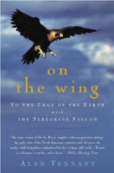Thanks to the leadership of the Peregrine Fund and other conservation groups, Falco peregrinus and its kindred birds of prey have been pulled from the edge of oblivion. Yet the stay of execution may only be temporary, Alan Tennant suggests in his spirited eco-memoir On the Wing. DDT has long been banned in America, thanks in part to Rachel Carson's book Silent Spring, but it is plentiful in the raptors' Central American wintering grounds, "part of the agricultural equipment of nearly every rural village between Tamaulipas and Venezuela." Things are no better on the northernmost extremes of the raptors' habitat, where massive concentrations of organochlorines -- in, among other settings, human breast milk -- mark civilization's progress in the Arctic.
As his book opens, in the mid-1980s, we find Tennant working as a volunteer falcon watcher on the Texas barrier islands. There he ran smack into the might of the U.S. Army, which, for mysterious reasons, bore much of the cost of the falcon-migration study in which he was participating. We can only imagine the Strangelovian purposes behind the Army's interest in such things, but whatever the case, Tennant quickly moved on, having liberated some choice radio-telemetry equipment with which to track a transmitter-carrying falcon to the Arctic.
It will not be the only crime he commits in these pages, aided and abetted by a World War II veteran aviator named George Vose, with whom he formed a mutual egging-on and falcon-chasing society, Tennant urging Vose to "go . . . where no one's ever gone," Vose growling by way of reply, "Ever known how to go."
The why of the transcontinental journey the two concoct is simple: Bird migration will forever remain a mystery unless we know where the birds go and what they do when they get there. For that we need good on-the-ground (or, in this case, in-the-air) data, and lots of it, all of which On the Wing elegantly delivers.
The hows form the heart of Tennant and Vose's ensuing adventures, which took them north across Canada -- illegally -- to the Arctic in a battered airplane that Tennant repeatedly likens to the plastic basket in which supermarket strawberries are sold. The description is apt, save that strawberry baskets don't go auguring into mountainsides, one of the many occupational hazards Tennant endured -- and describes -- so that we lesser birdwatchers do not have to.
The world of raptors, Tennant allows at the outset, is Hobbesian; certainly the lives of the pigeons and kittiwakes and starlings they encounter are short and come to a nasty end. Tennant's descriptions of raptor kills sometimes veer into the territory of those eco-snuff films on which cable channels seem to thrive: A shark finds its seal, a lion its wildebeest, and in a spray of blood we see natural selection at work.
So it was when, for instance, Tennant spotted a little falcon attacking three much larger teal in the Big Bend country of Texas. "They were right above me as the peregrine came up on them, and beneath the hawk's rippling flanks I could see it unsheathe its hidden yellow feet and swing them forward, dropping the long hind-talons that opened like a Barlow knife to rake a silent explosion of feathers from the last teal's back."
Such images are not for the squeamish. Little about nature is. But there are many rewards for readers who take such things as they come. One prize lies at the end of the book, when, somewhere over Mexico, Tennant and Vose traverse the storied "river of raptors" that joins the Arctic to the equator and points south, "millions of northern migrants making their way down the continent's central migration corridor."
It's a magnificent moment, one of many in what is, all in all, a fine vicarious experience for any reader with a liking for either birds of prey or death-defying stunts. The conceit of the journey in search of animals, whether a particular species or an entire menagerie, has informed much of the best nature writing of our time: Peter Matthiessen's The Snow Leopard, Robert Michael Pyle's Chasing Monarchs, Kenn Kaufman's Kingbird Highway, Doug Peacock's Grizzly Years, to name just a few. On the Wing fits neatly on the shelf next to these noteworthy books. It should hold up just as well as they in the coming years, even if all of us should hope for a happier ending than what, Tennant hints, really awaits our birds of prey -- and with them the rest of our world. •
Gregory McNamee is the author of "Gila: The Life and Death of an American River," "In the Presence of Wolves" and other books on the natural world.


